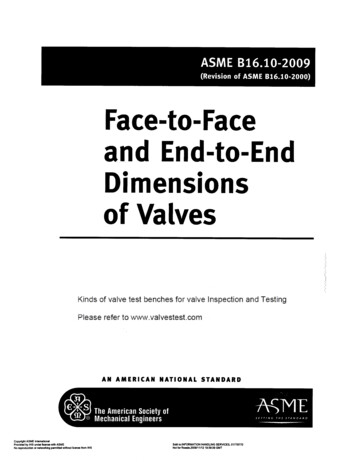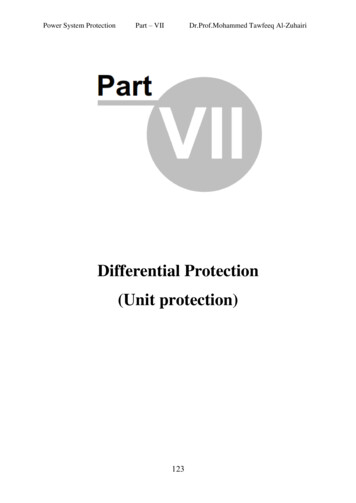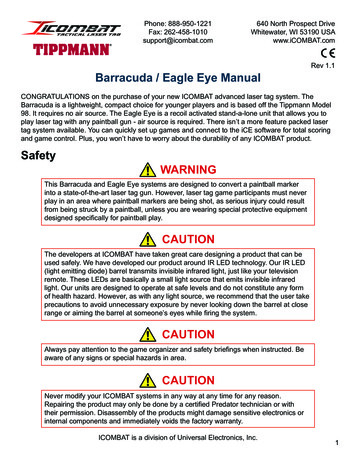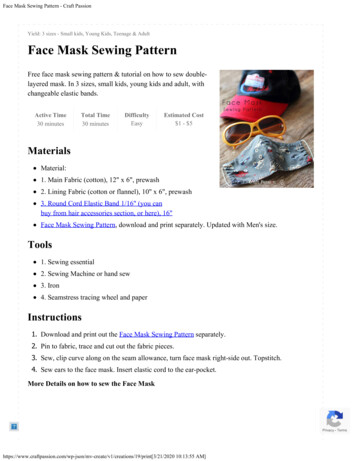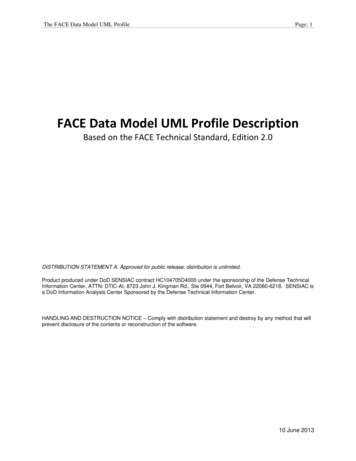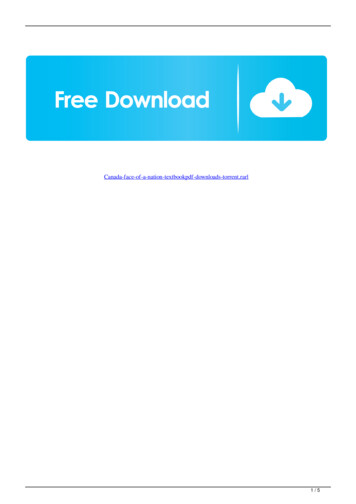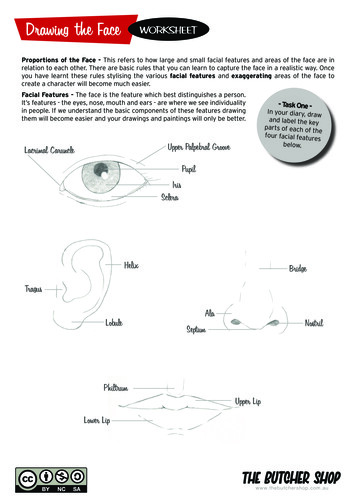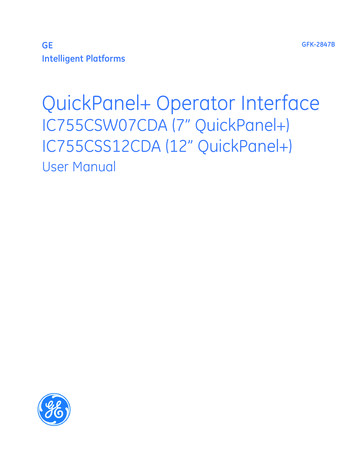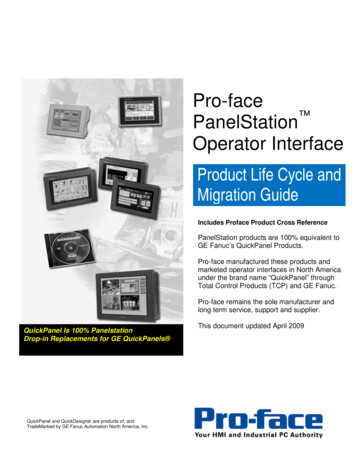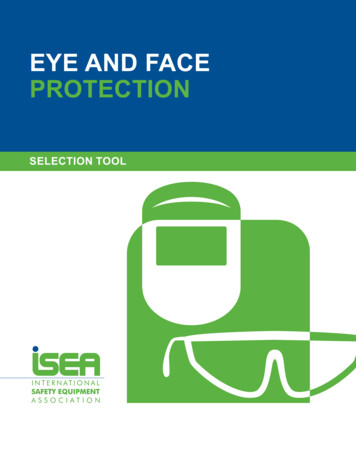
Transcription
EYE AND FACEPROTECTIONSELECTION TOOL
ANSI/ISEA Z87.1-2015Annex J. Eye and Face Selection Guide(informative)ANSI/ISEA Z87.1-2015Eye and Face Protector Selection GuideThis guide is not intended to be the sole reference in selecting the proper eye and face protector. A copy of this selection guide isalso available for download from ISEA’s website, www.safetyequipment.org.This information is intended to aid in identifying and selecting the types of eye and face protectors that are available, their capabilities and limitations for the hazards listed. Care should be taken to recognize the possibility of multiple and simultaneous hazard exposures and the chosen protector(s) should be able to protect against the highest level of each hazard. Some protectorsmay not be compatible with other personal protective equipment when worn together. The end user needs to carefully matchprotectors with other personal protective equipment to provide the protection intended. Protectors are generally available in avariety of styles and sizes and care should be taken to ensure that the right size is selected for a particular person ensuring comfort and proper fit. Protectors that fit poorly will not afford the protection for which they were designed.HazardProtectorsLimitationsMarking1IMPACT - Chipping, grinding, machining, masonry work, riveting, and sandingFlying fragments, objects,large chips, particles,sand, dirt, etc. Spectacles with side protection Goggles with direct or indirectventilation Faceshield worn over spectaclesor goggles Welding helmet worn over spectacles or goggles Loose-fitting respirator worn overspectacles or goggles Full-facepiece respiratorsCaution should be exercised in the use ofmetal frame protective devices in electrical hazard areas. Metal frame protectivedevices could potentially cause electricalshock and electrical burn through contactwith, or thermal burns from exposure tothe hazards of electrical energy, whichinclude radiation from accidental arcs.Impact rated: (spectacle lens)Z87 (all other lens)Z87 (plano frame)Z87-2 (Rx frame)To provide adequate protection, ensuregoggles fit tightly to the face.Atmospheric conditions and the restrictedventilation of a protector can causelenses to fog. Frequent cleaning may berequired.HEAT - Furnace operations - pouring, casting, hot dipping, gas cutting, and weldingHot sparksSplash from molten metal Spectacles with side protection Goggles with direct or indirectventilation Faceshield worn over spectacles or goggles Loose-fitting respirator worn overspectacles Full-facepiece respiratorSpectacles, cup and cover type gogglesdo not provide unlimited facial protection.Operations involving heat may also involve optical radiation. Protection fromboth hazards shall be provided.NOTE: There are currently no marking designations for eye protection to heat or hightemperature exposurein the ANSI/ISEAZ87.1-2015 standard. Faceshield worn over goggles Loose-fitting respirator worn overspectacles or goggles Full-facepiece respiratorPage 1
ANSI/ISEA Z87.1-2015HazardHigh temperature exposureProtectorsLimitationsMarking1 Goggles with indirect ventilation(eyecup or cover type) Faceshield worn over goggles) Loose-fitting respirator worn overspectacles or goggles Full-facepiece respiratorAtmospheric conditions and the restrictedventilation of a protector can causelenses to fog. Frequent cleaning may berequired.Splash/droplet: D3 Goggle with no ventilation (covertype) Faceshield worn over goggles Loose-fitting respirator worn overspectacles or goggles Full-facepiece respiratorAtmospheric conditions and the restrictedventilation of a protector can causelenses to fog. Frequent cleaning may berequired. Screen faceshield over spectacles or goggles Reflective faceshield over spectacles or gogglesCHEMICAL – Liquids, acid and chemical handling, degreasing, plating.Splash, droplets andspraysIrritating MistTo provide adequate protection, ensuregoggles fit tightly to the face.To provide adequate protection, ensuregoggles fit tightly to the face.NOTE: There are currently no marking designations for eye protection to Irritating mistsexposure in theANSI/ISEA Z87.1-2015standard.DUST - Woodworking, buffing, general dusty conditionsNuisance dust Goggles with direct or indirectventilation (eyecup or covertype) Full-facepiece respiratorAtmospheric conditions and the restrictedventilation of a protector can causelenses to fog. Frequent cleaning may berequired.Dust: D4To provide adequate protection, ensuregoggles fit tightly to the face.Fine dust Goggles with indirect ventilationor no ventilation Full-facepiece respiratorTo provide adequate protection, ensuregoggles fit tightly to the face.Fine dust: D5 Spectacles with side protection Goggles with direct or indirectventilation Faceshield worn over spectaclesor goggles Welding helmet worn over spectacles or goggles Loose-fitting respirator worn overspectacles or goggles Full-facepiece respiratorsFor proper fit of protector; there shall beno penetration of direct infrared spectralight in all non-lens areas.IR: R and scale numberOPTICAL RADIATIONInfrared Radiation (IR)Side shields shall have filtering capabilityequal to or greater than the front lenses.Page 2
ANSI/ISEA Z87.1-2015HazardVisible Light (Glare)Ultraviolet Radiation (UV)LasersProtectorsLimitationsMarking1 Spectacles with side protection Goggles with direct or indirectventilation Faceshield worn over spectaclesor goggles Welding helmet worn over spectacles or goggles Loose-fitting respirator worn overspectacles or goggles Full-facepiece respirators Spectacles with side protection Goggles with direct or indirectventilation Faceshield worn over spectaclesor goggles Welding helmet worn over spectacles or goggles Loose-fitting respirator worn overspectacles or goggles Full-facepiece respiratorsRefer to ANSI Z136.1-2014 “SafeUse of Lasers”, for guidance inchoosing the correct protectiveeyewear when working with lasers.For proper fit of protector; there shall beno penetration of direct visible light in allnon-lens areas.Visible: L and scalenumberSide shields shall have filtering capabilityequal to or greater than the front lenses.For proper fit of protector; there shall beno penetration of direct ultraviolet light inall non-lens areasUV: U and scale numberSide shields shall have filtering capabilityequal to or greater than the front lenses.NOTE: There are currently no marking designations for eye protection to Lasers in theANSI/ISEA Z87.1-2015standard.Page 3
ANSI/ISEA Z87.1-2015HazardArc Welding: ArcProcess Examples:Shielded Metal Arc Welding(SMAW)Gas Metal Arc Welding(GMAW)Gas Tungsten Arc Welding(GTAW)Air Carbon Arc Welding(CAC-A)Carbon Arc Welding (CAW)ProtectorsLimitations Welding helmet over spectaclesor goggles Handshield over spectacles orgoggles Welding Respirator TYPICAL FILTER LENSSHADE: 10-14Protection from optical radiation is directly related to filter lens density. Select thedarkest shade that allows adequate taskperformance.For proper fit of protector; there shall beno penetration of direct visible light in allnon-lens areas.Marking1Welding: W shadenumberUV: U scale numberVisible: L scale numberIR: R scale numberVariable tint: VSpecial purpose: SSide shields shall have filtering capabilityequal to or greater than the front lenses.Welding helmets are intended to shieldthe eyes and face from optical radiation,heat, and impact. Welding helmetsshould not be used as a stand-aloneprotective devices and should be worn inconjunction with goggles or spectacles.Plasma Arc Welding(PAW)Plasma Arc Cutting (PAC)Viewing electric arc furnaces and boilers.Filter lens shade selection is to be madebased on the welding process, arc current, electrode size and/or plate thickness. Use ANSI Z49.1:2012, Table 1,Guide for Shade Numbers, to select theproper filter lens shade for both protection and comfort (reduction in visibleglare).Note: Filter lenses shall meet the requirements for shade designations intable 6 of ANSI/ISEA Z87.1-2015.Page 4
ANSI/ISEA Z87.1-2015HazardOxyfuel Gas Welding:Process Examples:Oxyfuel Gas Welding(OFW)Viewing gas-fired furnacesand boilersProtectorsLimitations Welding goggles Welding helmet over spectaclesor goggles Welding faceshield over spectacles or gogglesTYPICAL FILTER LENS SHADE:6 -8Protection from optical radiation is directly related to filter lens density. Select thedarkest shade that allows adequate taskperformance.For proper fit of protector; there shall beno penetration of direct visible light in allnon-lens areas.Marking1Welding: W shadenumberUV: U scale numberVisible: L scale numberIR: R scale numberVariable tint: VSpecial purpose: SSide shields shall have filtering capabilityequal to or greater than the front lenses.Welding helmets are intended to shieldthe eyes and face from optical radiation,heat, and impact. Welding helmetsshould not be used as a stand-aloneprotective devices and should be worn inconjunction with goggles or spectaclesOxyfuel or Oxygen CuttingTorch brazingTorch solderingGlare Welding goggles Welding helmet over spectaclesor goggles Welding faceshield over spectacles or gogglesTYPICAL FILTER LENSSHADE:3-6 Welding goggles Welding helmet over spectaclesor goggles Welding faceshield over spectacles or gogglesTYPICAL FILTER LENS SHADE:3-4 Spectacles Welding faceshield over spectaclesTYPICAL FILTER LENS SHADE:2 Spectacles with or without sideprotection Faceshield over spectacles orgoggles.Filter lens shade selection is to be madebased on the welding process, arc current, electrode size and/or plate thickness. Use ANSI Z49.1:2012, Table 1,Guide for Shade Numbers, to select theproper filter lens shade for both protection and comfort (reduction in visibleglare).Note: Filter lenses shall meet the requirements for shade designations intable 6 of ANSI/ISEA Z87.1-2015.Shade or special purpose lenses, assuitable.Note: Refer to definition of special purpose lenses in ANSI/ISEA Z87.1-2015.1. Refer to ANSI/ISEA Z87.1-2015 Table 3 for complete marking requirements.2. Refer to ANSI Z49.1: 2012: “Safety in Welding, Cutting, and Allied Processes”, Table 1, Guide for Shade Numbers, to selectthe proper lens filter protective shade based on welding process, arc current (in amperes), Electrode Size (arc welding only) andmetal plate thickness (for oxyfuel and oxygen cutting only).3. Refer to ANSI Z136.1-2014 “Safe Use of Lasers”, for guidance on choosing the correct protective eyewear when working withlasers.Page 5
ness. Use ANSI Z49.1:2012, Table 1, Guide for Shade Numbers, to select the proper filter lens shade for both protec-tion and comfort (reduction in visible glare). Note: Filter lenses shall meet the re-quirements for shade designations in table 6 of ANSI/ISEA Z87.1-2015. Welding: W. shade number. UV: U . scale number. Visible: L. scale num-ber. IR: R
